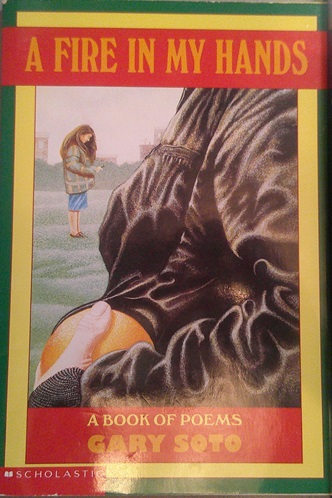A Fire in My Hands: A Book of Poems by Gary Soto, illustrated by James M. Cardillo.
Scholastic, New York, 1990.
Poetry, 64 pages.
Lexile: NP . (What does NP mean in Lexile?)
AR Level: 5.4 (worth 1.0 points) .
NOTE: See review for age appropriateness.
A collection of Gary Soto’s poems about growing up Mexican-American in the San Joaquin valley.

This was languishing in a little free library we frequent, untouched for far too long. I will probably release it back into a different free book environment if none of the kids I know want it.
With only 23 poems this is a slim volume. I thought at first that all or most were written for this book, but they are reprinted from other books or magazines. The majority come from his collection Black Hair, but some are from other sources.
The book also includes a forward, Q&A, and a few lines introducing each individual poem. That helps give context to the poems, adds more of a narrative flow to the book, and also helps make it a bit more substantial. It makes the collection more useful for teachers too.
I’ll start with a few pieces which might trouble modern readers. This was published in 1990 and about half the pieces refer to Soto’s own childhood in the 1950s and 1960s. (The rest refer to his daughter’s early childhood, his own adulthood, or aren’t tied to a particular timeframe.) So at points it’s dated in a way that might require explanation now.
For example, Soto sells oranges for a nickel each, sees a blimp fly overhead, watches a girl use an encyclopedia for her homework, hitchhikes, and is generally able to freely run about in a way that most children in the USA today no longer do. I think some additional support from the introductory text could help make some of these items more readable if a new edition was released.

The other concern is harder to define. Young Soto is obsessed with girls (as many adolescents are), but the attitude here felt like maybe young women were not expected readers. In ‘That Girl’ he blames various girls working near him at the library for him not getting his homework done because they are so attractive he has to keep looking at them and can’t focus. Adults should be able to recognize that he’s responsible for his own choices and the young ladies minding their own business at the library bear no responsibility for his decisions.
Several other poems make more subtle references along this same theme or relating to women on a mostly physical level. Soto references Catholic skirts a lot, and apparently sweater colors? I can see where this is useful for boys experiencing those feelings, but it seems unusual for a book marketed to elementary students who might internalize some of his commentary.
Those concerns aside, I was very taken with this short collection. Soto offers us a peek into a different world. He sells oranges door to door, and at one point pays for a chocolate bar for the girl he likes with an orange. He experienced a kind of freedom to roam and direct his own life that few young people have today even into early adulthood. Soto and his peers directed their own play with little adult supervision, yet every adult on the block was looking out for them.

I personally enjoyed the poems about his relationship with his daughter best, and the nature poems after that. “Failing in the Presence of Ants” and “Teaching Numbers” are two I’ll revisit. His poems about baseball and hitchhiking were less interesting to me than the ones about growing a pepper tree or visiting the riverbend in October.
The poems are brief but nicely varied, with quick line breaks. Most have relatable topics and emotions. Soto incorporates all the senses and many different emotions. The book is also arranged well, with poems flowing one into the next. Cardillo’s illustrations suit the writing well and don’t detract, although with the stippling and crosshatching modern readers may find them dated.
Above I discussed a bit about the romance, but a few other pieces of content for adults to consider. ’Learning to Bargain’ involves asking for a bribe in order to not tell another boy’s mother that he killed a cat. The intro seems to indicate that wasn’t what happened, and the question section confirms that, but it helped push this book to MG/YA territory for me.
Another poem involves hitchhiking and drinking beer, and a third focuses on a homeless couple where the husband stays alive only for his disabled wife. This theme is also earlier in the poem when a boy “turns to the dreamed girl / He’d jump from a tree to die for.” Another poem involves a friend falling out a (luckily screen) window. Several poems refer to Soto being Catholic, and some to Protestants as a general group rather than specific denominations, one references a girl possibly being Jewish. I’ve tagged this with baseball and dancing as there are poems which focus on those, although neither are major themes.

Because of the dead cat, teen drinking, and romance concerns detailed above, I wouldn’t suggest this for elementary generally, although it may still be appropriate for some students, classes, or families. Still useful for upper middle grade, or early high school as Soto is well known and widely available, and this collection is very short, making it accessible and giving students more time to study the poems.
Since this follows him from childhood to parenthood and my copy doesn’t have any stated age range, it could work well for hi-low collections. I also could see this potentially resonating with ESL classes or students, especially older students who may relate more to his youthful stories or his experiences of adulthood.